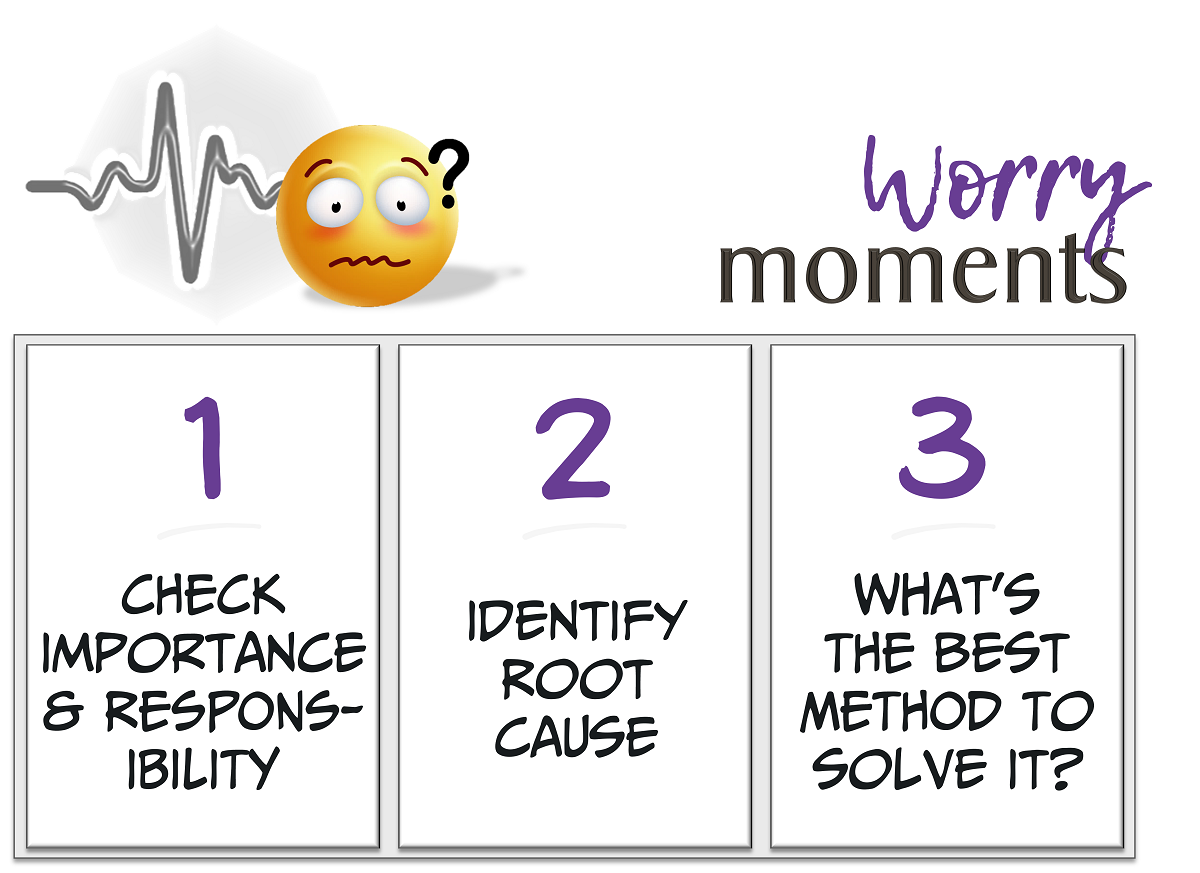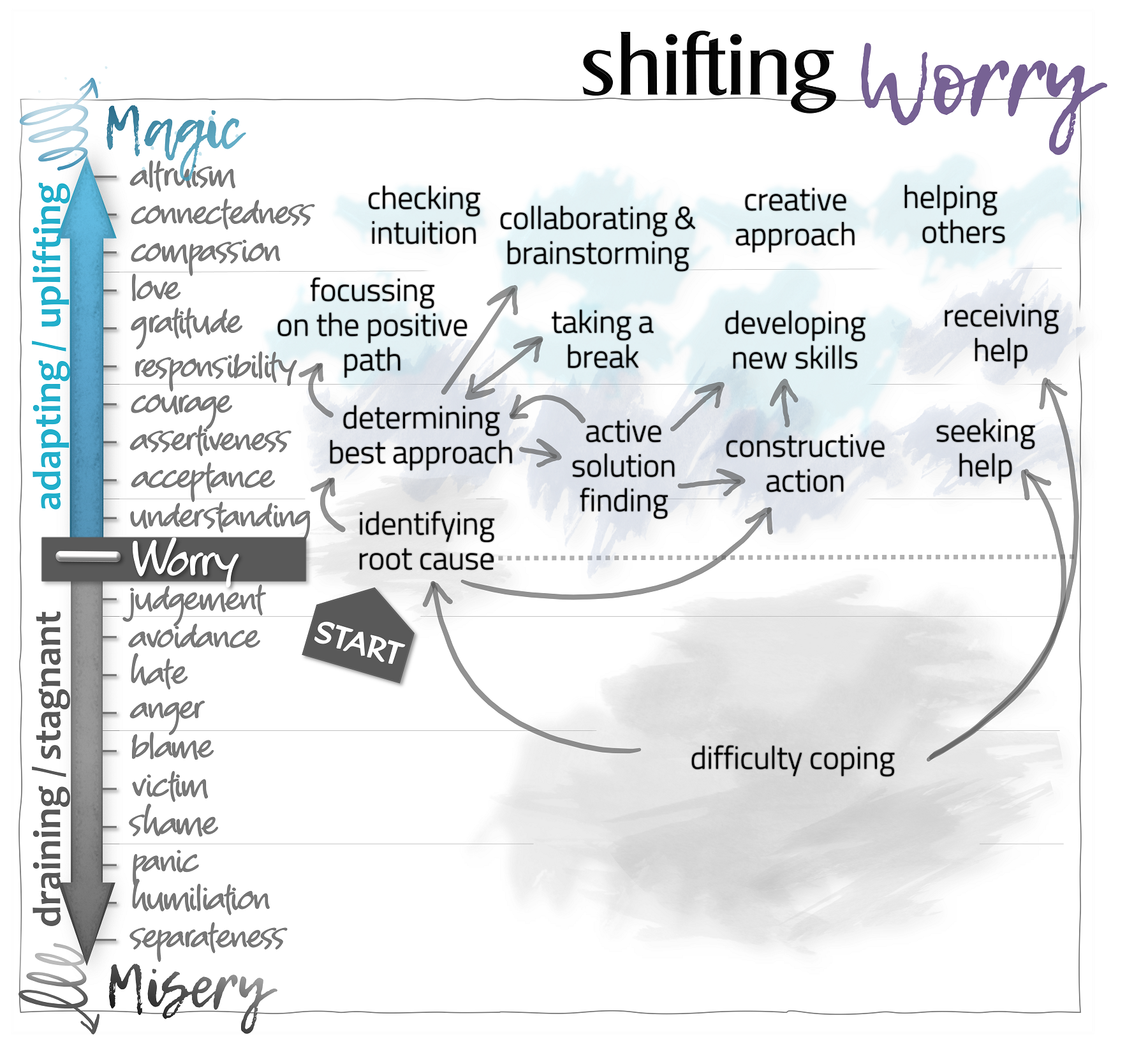What Is It About?
Napkin Version
Worry is like the strategic thinker that works to avoid potential risks or negative situations.
If we have all the information we need, and a variety of problem-solving tools and resources available to us, Worry can work well to nudge us towards understanding and managing the risk better, or in helping us to see a beneficial change of perspective e.g. accepting the things we can’t control in life.
If however we don’t have all the info and tools we need to understand and work through the problem, Worry can become burdensome as we suffer the endless loop of trying to resolve something we aren’t able to.
Different problems require different approaches, techniques, tools, and information to solve them. The key is in knowing what to let go of, and what techniques to use, when, as we make our way through solving the problem.
-
It’s usually beneficial to start by checking with ourselves on how important the perceived problem is to us, what our responsibility is, and how much control we have.
-
If it is important to us and requires our attention, then digging to get to the root cause provides a useful starting point for working through it.
-
Taking a moment to decide upon the method we’ll use for solving the problem e.g., mapping it out, talking with people, researching and analysing info, testing scenarios out, using our intuition, having a creative brainstorm, etc. can make the solving of it a lot faster and easier.
If it is a significant problem to solve, it may be helpful to use a number of different methods at different points of the process. So it is worthwhile stepping back from time to time to consider our best approach.
Handling Worry
In The Moment
Training our brain to use a relevant process helps us to focus more effectively and move on more easily. Using it often will also help our brain to catch Worry sooner, making it easier to manage.
It’s usually beneficial to start by checking with ourselves on how important the perceived problem is to us, what our responsibility is, and how much control we have.
If it is important to us and requires our attention, then digging to get to the root cause provides a useful starting point for working through it.
Taking a moment to decide upon the method we’ll use for solving the problem e.g., mapping it out, talking with people, researching and analysing info, testing scenarios out, using our intuition, having a creative brainstorm, etc. can make the solving of it a lot faster and easier.
If it is a significant problem to solve, it may be helpful to use a number of different methods at different points of the process. So it is worthwhile stepping back from time to time to consider our best approach.
Self-Reflection
If the emotion feels quite troubling, it’s usually worth checking if something else is going on first.
By resolving things in ourselves and clearing any other residual emotions, we can reduce the intensity of the emotion - now and when we encounter it again in future.
Doing so also makes us less likely to ‘attract’ other difficulties that leave us feeling the same way.
See the Processing and Clearing an Emotion page for a generic process to resolve and clear an emotion.
Working Through Worry
The actions we choose to take in response to an emotion can make a significant difference to how well we adjust and move on from it.
The more we take genuine actions that are uplifting and ‘right’ i.e., are good for ourselves and everyone else (including the environment and other living beings) - for now, and over the long-term, the better our experience of life becomes.
The following can help us to work through Worry:
Having the courage to face things, even if it is difficult.
Asking ourselves what’s really bothering us, then keep asking why that is, until we get to the root cause.
Checking if it’s worth our concern e.g. how likely is it to happen, what’s the most likely outcome, and what’s our responsibility?
Scheduling to work on it at a more suitable time.
If it’s not worth our focus, distracting ourselves onto something more important or enjoyable, to let it fade away.
If it is important, writing down the problem, then re-defining it (and the outcome we want) in a positive and constructive way.
Visualising the positive outcome, as though it has already happened, and keeping that in mind as we find ways to achieve it.
Using a variety of problem-solving techniques (logical, creative, intuitive, etc) to come up with different options and possibilities.
Doing research to have a good understanding of the situation.
Writing notes and using visual tools e.g. mind maps, timelines.
Checking any assumptions that may have an impact.
Chunking the outcome we want into easier steps.
Working with what we have, and what is positive and doable.
Putting all of the information in front of us, so our brain can take in and process everything together.
Taking breaks, and letting our sub-conscious mind process it.
Checking our intuition for further insight, or to ‘test’ an option out.
Brainstorming with others who are more experienced in the situation, or who are great problem solvers.
Clearing Residual Worry
Emotional energy can stick with us, even after we have worked through and resolved whatever caused it.
There are a number of ways we can clear the energy, including doing something physical in nature, imagining the emotion leaving our body, or for more intense emotions, there is a variety of different therapies and alternative forms of energy healing that can also help.
-
The short video below has been created to help imagine emotional energy leave the body, using the following visualisation process:
Imagine holding a ball of energy in your hands, and ‘charging’ it with the feeling of love, and anything else that would help to offset it (especially any feelings that were missing in the situation)
Imagine any residual Anger energy flowing out of your body, into the ball, and being transformed into the positive equivalent.
Once all the residual energy has left, imagine the ball shooting far out into the atmosphere and dissolving into pure white light energy.







